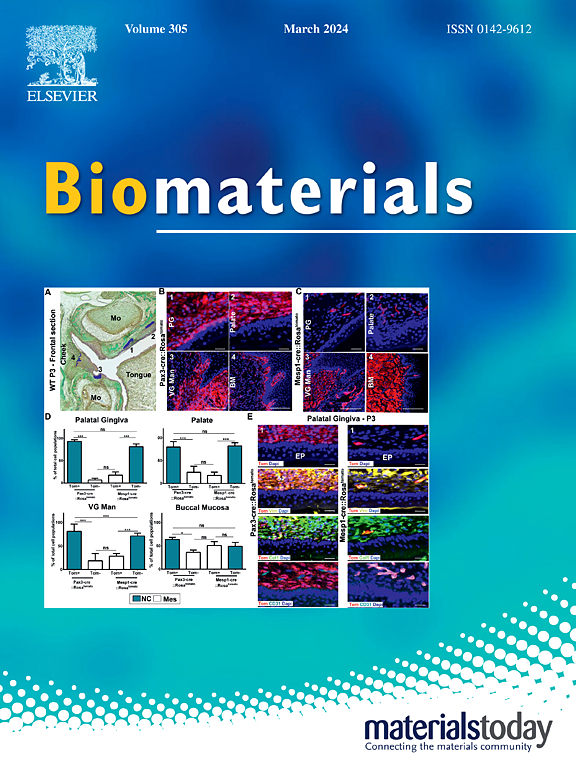A biomaterial-based platform of pancreatic cancer reveals kallikrein-related peptidase 6 (KLK6) as a mediator of neutrophil recruitment and immunosuppression
IF 12.9
1区 医学
Q1 ENGINEERING, BIOMEDICAL
引用次数: 0
Abstract
In pancreatic cancer, response to treatment is impaired by the tumor microenvironment (TME), forming a desmoplastic barrier. However, experimental 3D models that adequately model the pancreatic TME are still missing. Here, we employ a matrix metalloproteinase (MMP)-degradable star-shaped poly(ethylene glycol) (star-PEG)-heparin hydrogel matrix to replicate pathophysiological features of the pancreatic environment and investigate the role of the tumor-associated protease kallikrein-related peptidase 6 (KLK6) in 3D. Coupled with CRISPR/Cas9, we found that KLK6 promotes cancer growth. RNA sequencing revealed that KLK6 impairs genes associated with antigen presentation and neutrophil recruitment, all major immune suppressors in pancreatic cancer. In patients, KLK6 expression correlated with neutrophil-recruiting chemokines. Neutrophil recruitment was recapitulated in vitro, which was lower in the absence of KLK6. Treatment of neutrophils with cell-conditioned KLK6 knockout medium reduced the immunosuppressive phenotype, indicated by decreased arginase 1 (Arg1) expression. KLK6 also impacted genes associated with immune checkpoint inhibition and decreased cell responses to anti-PD-1 checkpoint blockade in vitro. Our study identified KLK6 as a drug target as it regulates neutrophil recruitment, immunosuppression, and cell responses to anti-PD-1 therapy in a biomaterial-based disease model.
基于生物材料的胰腺癌平台揭示了钾化钾素相关肽酶6 (KLK6)作为中性粒细胞募集和免疫抑制的介质
在胰腺癌中,对治疗的反应受到肿瘤微环境(TME)的损害,形成了一个结缔组织屏障。然而,能够充分模拟胰腺TME的实验性3D模型仍然缺失。在这里,我们采用基质金属蛋白酶(MMP)-可降解星形聚乙二醇(star-PEG)-肝素水凝胶基质复制胰腺环境的病理生理特征,并在3D中研究肿瘤相关蛋白酶kallikrein相关肽酶6 (KLK6)的作用。结合CRISPR/Cas9,我们发现KLK6促进癌症生长。RNA测序显示,KLK6损害了与抗原呈递和中性粒细胞募集相关的基因,这些基因都是胰腺癌的主要免疫抑制因子。在患者中,KLK6的表达与中性粒细胞募集趋化因子相关。中性粒细胞招募在体外重现,在缺乏KLK6的情况下,中性粒细胞招募减少。用细胞条件的KLK6敲除培养基处理中性粒细胞可降低免疫抑制表型,表现为精氨酸酶1 (Arg1)表达降低。在体外实验中,KLK6还影响与免疫检查点抑制相关的基因,并降低细胞对抗pd -1检查点阻断的反应。我们的研究确定了KLK6作为药物靶点,因为它在基于生物材料的疾病模型中调节中性粒细胞募集、免疫抑制和细胞对抗pd -1治疗的反应。
本文章由计算机程序翻译,如有差异,请以英文原文为准。
求助全文
约1分钟内获得全文
求助全文
来源期刊

Biomaterials
工程技术-材料科学:生物材料
CiteScore
26.00
自引率
2.90%
发文量
565
审稿时长
46 days
期刊介绍:
Biomaterials is an international journal covering the science and clinical application of biomaterials. A biomaterial is now defined as a substance that has been engineered to take a form which, alone or as part of a complex system, is used to direct, by control of interactions with components of living systems, the course of any therapeutic or diagnostic procedure. It is the aim of the journal to provide a peer-reviewed forum for the publication of original papers and authoritative review and opinion papers dealing with the most important issues facing the use of biomaterials in clinical practice. The scope of the journal covers the wide range of physical, biological and chemical sciences that underpin the design of biomaterials and the clinical disciplines in which they are used. These sciences include polymer synthesis and characterization, drug and gene vector design, the biology of the host response, immunology and toxicology and self assembly at the nanoscale. Clinical applications include the therapies of medical technology and regenerative medicine in all clinical disciplines, and diagnostic systems that reply on innovative contrast and sensing agents. The journal is relevant to areas such as cancer diagnosis and therapy, implantable devices, drug delivery systems, gene vectors, bionanotechnology and tissue engineering.
 求助内容:
求助内容: 应助结果提醒方式:
应助结果提醒方式:


